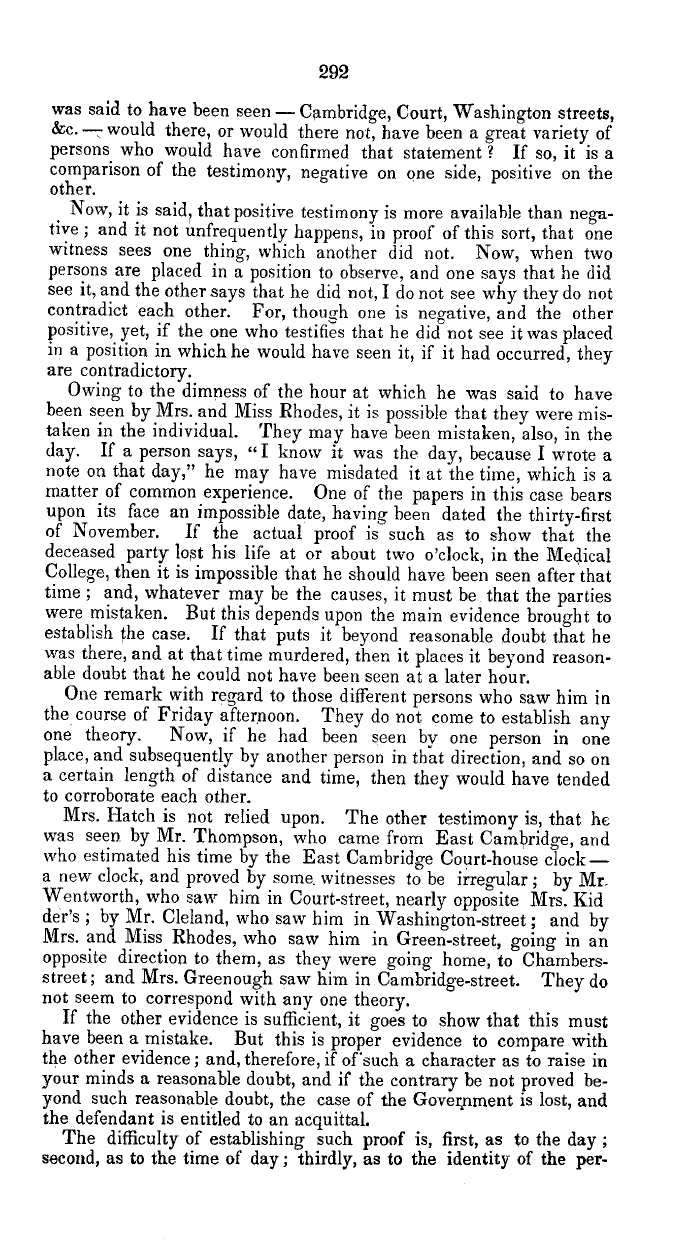|
292
was said to have been seen-Cambridge, Court, Washington streets,
&c. - would there, or would there not, have been a great variety of
persons who would have confirmed that statement ? If so, it is a
comparison of the testimony, negative on one side, positive on the
other.
Now, it is said, that positive testimony is more available than nega-
tive ; and it not unfrequently happens, in proof of this sort, that one
witness sees one thing, which another did not. Now, when two
persons are placed in a position to observe, and one says that he did
see it, and the other says that he did not, I do not see why they do not
contradict each other. For, though one is negative, and the other
positive, yet, if the one who testifies that he did not see it was placed
m a position in which he would have seen it, if it had occurred, they
are contradictory.
Owing to the dimness of the hour at which he was said to have
been seen by Mrs. and Miss Rhodes, it is possible that they were mis-
taken in the individual. They may have been mistaken, also, in the
day. If a person says, °' I know it was the day, because I wrote a
note on that day," he may have misdated it at the time, which is a
matter of common experience. One of the papers in this case bears
upon its face an impossible date, having been dated the thirty-first
of November. If the actual proof is such as to show that the
deceased party lost his life at or about two o'clock, in the Medical
College, then it is impossible that he should have been seen after that
time ; and, whatever may be the causes, it must be that the parties
were mistaken. But this depends upon the main evidence brought to
establish the case. If that puts it beyond reasonable doubt that he
was there, and at that time murdered, then it places it beyond reason-
able doubt that he could not have been seen at a later hour.
One remark with regard to those different persons who saw him in
the, course of Friday afternoon. They do not come to establish any
one theory. Now, if he had been seen by one person in one
place, and subsequently by another person in that direction, and so on
a certain length of distance and time, then they would have tended
to corroborate each other.
Mrs. Hatch is not relied upon. The other testimony is, that he
was seen. by Mr. Thompson, who came from East Cambridge, and
who estimated his time by the East Cambridge Court-house clock-
a new clock, and proved by some. witnesses to be irregular; by Mr.
Wentworth, who saw him in Court-street, nearly opposite Mrs. Kid
der's ; by Mr. Cleland, who saw him in Washington-street; and by
Mrs. and Miss Rhodes, who saw him in Green-street, going in an
opposite direction to them, as they were going home, to Chambers-
street; and Mrs. Greenough saw him in Cambridge-street. They do
not seem to correspond with any one theory.
If the other evidence is sufficient, it goes to show that this must
have been a mistake. But this is proper evidence to compare with
the other evidence; and, therefore, if of'such a character as to raise in
your minds a reasonable doubt, and if the contrary be not proved be-
yond such reasonable doubt, the case of the Government is lost, and
the defendant is entitled to an acquittal.
The difficulty of establishing such proof is, first, as to the day ;
second, as to the time of day; thirdly, as to the identity of the per-
|

